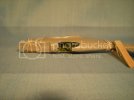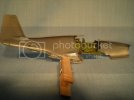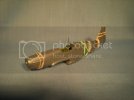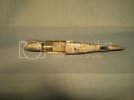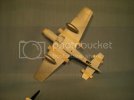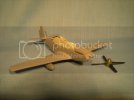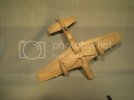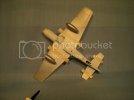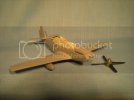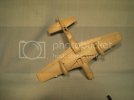the Baron
Ich bin ja, Herr, in Deiner Macht
- Joined
- May 12, 2009
- Messages
- 1,973
Hi, all! I'd like to share a look at my current project, two P-51B's in 1/48. One is the classic Monogram kit, which I got as a bagged kit, without instructions or decals off eBay, and the other is the ICM kit that I got from Squadron in their July sale. I'm building these for the December meeting of my club; our theme is "Mustangs". I've been looking for an opportunity to build the ICM kit since I got it, so this was a happy coincidence.
This first picture is of my first step, which was to prep the interiors of the kits:

The Monogram kit is on the right, with an interior green laid down. In the center is the ICM clear sprue, which includes a second instrument panel marked "not to be used" in the instructions. Since the Monogram kit had no panel, I'll use the extra there. It might not be 100% for a -B, but the canopy will be closed, and it's better than nothing.
Next, shots of the cockpits of each kit, with pretty much all of the detail that I'm going to use. The Monogram kit, left and right halves:
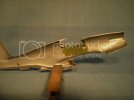

and the ICM kit, left and right halves:
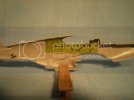
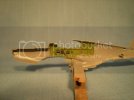
Comparing the two kits, the Monogram kit has better and more accurate side panel details than the ICM kit, despite its relative age. The ICM kit has the side panels molded as separate parts that must be attached to the fuselage halves, and details do not match the photos I have in Squadron's "P-51 In Action", and "Mustang at War". The Monogram sidewalls are pretty much spot-on. Also, the ICM kit has a nasty sink mark right in the middle of the switch box on the right side at the front. I left it as-is, though, because again, the canopy will be closed, so it won't really be seen.
I've heard, by the way, that the ICM kit is a copy of another manufacturer's kit--maybe Tamiya? Maybe one of you knows for sure.
Here are the seat sections of the respective kits' cockpits, ICM on the left and Monogram on the right:

Now here, the ICM kit does have better detail. The Monogram floor is simple, with just some raised detail to suggest rudder pedals (which, you Mustang fans know, were mounted under the instrument panel, not on the floor). The ICM kit includes the radio deck behind the cockpit, which is represented on the Monogram kit by the top radio box, molded on the fuselage halves. Again, though, when everything is closed up, I suspect that the ICM radio deck will not be that visible. The ICM kit also includes the radiator and detail for the ducting. The Monogram kit doesn't depict this at all; the intake and the exhaust vent are molded shut. I have opened them, so that at least they will be open on the finished model.
Here are the instrument panels:

The panel on the left is the panel that the ICM instructions direct me to use for this kit; the one on the right is marked not to be used, in the instructions. I'm not sure why they have the two panels, because I'm not sure that there differences in the -B/C series panels. In any case, since there's no panel in my Monogram kit--I can't remember if this kit had one or not, or if it used a decal; it's been over 30 years since I last built it--I'll use this extra panel in the Monogram kit. The extra panel also has the rudder pedals molded onto the piece; the other panel consists of the panel and a separate part for the pedals. I was going to try painting the back of the pieces black, and painting the bezels and frame black, leaving the faces clear, but in the end, it was easier to use the usual method of painting the whole front black, drybrushing white, and then adding a drop of Future in each instrument face, and I'm happy with the way they turned out.
The last picture is a shot of the figures, which you all know, are one of the things I like about my aircraft, I really do:

From right to left, the Monogram pilot, who also flies their P-47 kits; the ICM pilot, who is very reminiscent of the Eduard pilot in the P-39 kits; and a spare standing figure that I have, who will be posed on the ground with either of these kits. I'm not sure if he's a Monogram figure, or if he's a Tamiya figure. He's very similar to one of the standing figures included with the classic large bomber kits, but the pose is slightly different. My buddy Joe Leonetti gave me that figure in a swap, so I don't really know where he came from. Maybe one of you knows?
Right now, I have to finish the pilots, before I can close up the fuselages. Test fitting shows that I will have to sand the ICM cockpit to get the halves to close snugly. The Monogram kit has a little bit of gappage, but nothing that gentle pressure during glue curing can't fix. Also, the ICM kit has no locator pins, at all. There are some tabs and slots on some pieces, but otherwise, I need to apply care.
I hope to have more progress to share over the next couple of days, since I've got time to devote to this project. As always, comments/criticisms/tips are welcome, and thanks for looking!
YbiC
Brad
This first picture is of my first step, which was to prep the interiors of the kits:

The Monogram kit is on the right, with an interior green laid down. In the center is the ICM clear sprue, which includes a second instrument panel marked "not to be used" in the instructions. Since the Monogram kit had no panel, I'll use the extra there. It might not be 100% for a -B, but the canopy will be closed, and it's better than nothing.
Next, shots of the cockpits of each kit, with pretty much all of the detail that I'm going to use. The Monogram kit, left and right halves:


and the ICM kit, left and right halves:


Comparing the two kits, the Monogram kit has better and more accurate side panel details than the ICM kit, despite its relative age. The ICM kit has the side panels molded as separate parts that must be attached to the fuselage halves, and details do not match the photos I have in Squadron's "P-51 In Action", and "Mustang at War". The Monogram sidewalls are pretty much spot-on. Also, the ICM kit has a nasty sink mark right in the middle of the switch box on the right side at the front. I left it as-is, though, because again, the canopy will be closed, so it won't really be seen.
I've heard, by the way, that the ICM kit is a copy of another manufacturer's kit--maybe Tamiya? Maybe one of you knows for sure.
Here are the seat sections of the respective kits' cockpits, ICM on the left and Monogram on the right:

Now here, the ICM kit does have better detail. The Monogram floor is simple, with just some raised detail to suggest rudder pedals (which, you Mustang fans know, were mounted under the instrument panel, not on the floor). The ICM kit includes the radio deck behind the cockpit, which is represented on the Monogram kit by the top radio box, molded on the fuselage halves. Again, though, when everything is closed up, I suspect that the ICM radio deck will not be that visible. The ICM kit also includes the radiator and detail for the ducting. The Monogram kit doesn't depict this at all; the intake and the exhaust vent are molded shut. I have opened them, so that at least they will be open on the finished model.
Here are the instrument panels:

The panel on the left is the panel that the ICM instructions direct me to use for this kit; the one on the right is marked not to be used, in the instructions. I'm not sure why they have the two panels, because I'm not sure that there differences in the -B/C series panels. In any case, since there's no panel in my Monogram kit--I can't remember if this kit had one or not, or if it used a decal; it's been over 30 years since I last built it--I'll use this extra panel in the Monogram kit. The extra panel also has the rudder pedals molded onto the piece; the other panel consists of the panel and a separate part for the pedals. I was going to try painting the back of the pieces black, and painting the bezels and frame black, leaving the faces clear, but in the end, it was easier to use the usual method of painting the whole front black, drybrushing white, and then adding a drop of Future in each instrument face, and I'm happy with the way they turned out.
The last picture is a shot of the figures, which you all know, are one of the things I like about my aircraft, I really do:

From right to left, the Monogram pilot, who also flies their P-47 kits; the ICM pilot, who is very reminiscent of the Eduard pilot in the P-39 kits; and a spare standing figure that I have, who will be posed on the ground with either of these kits. I'm not sure if he's a Monogram figure, or if he's a Tamiya figure. He's very similar to one of the standing figures included with the classic large bomber kits, but the pose is slightly different. My buddy Joe Leonetti gave me that figure in a swap, so I don't really know where he came from. Maybe one of you knows?
Right now, I have to finish the pilots, before I can close up the fuselages. Test fitting shows that I will have to sand the ICM cockpit to get the halves to close snugly. The Monogram kit has a little bit of gappage, but nothing that gentle pressure during glue curing can't fix. Also, the ICM kit has no locator pins, at all. There are some tabs and slots on some pieces, but otherwise, I need to apply care.
I hope to have more progress to share over the next couple of days, since I've got time to devote to this project. As always, comments/criticisms/tips are welcome, and thanks for looking!
YbiC
Brad

